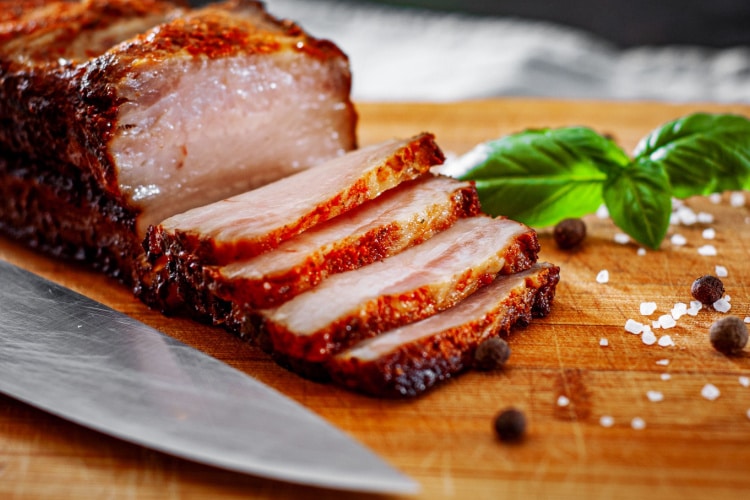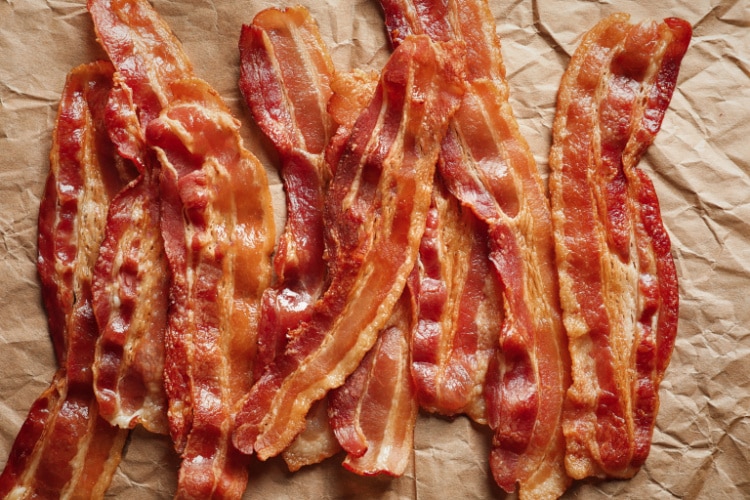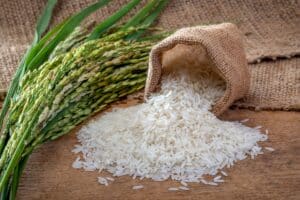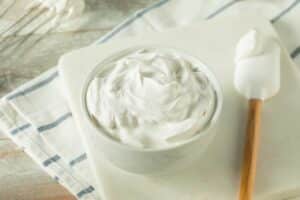
Shopping for pork cuts is a rather perplexing experience. In some instances, the similarities are so glaring that it’s difficult to distinguish one pork cut from another. While some pieces of meat and deli meat are noticeably different from one another, salt pork and bacon are rather similar.
For many years, sailors and soldiers on long voyages have enjoyed salt pork as their main source of protein because of how well it keeps.

Bacon, on the other hand, has managed to become one of the most popular breakfast protein options, and for a good reason — its smokey taste and crispy texture are sublime.
Undoubtedly, bacon and salt pork have some similarities. However, there are a few significant differences as well. For example, one is saltier than the other. But are they interchangeable? Is one healthier than the other? Let’s see what makes them different in more detail.
Difference Between Salt Pork and Bacon
The main difference between these two pork cuts is that salt pork is a salty and savory meat that’s cured with salt, whereas bacon is a salty and smoky meat that is both cured and smoked.
Bacon and cured salt pork are both made from pork belly. But throughout the production process and during cooking time, salt pork and bacon become radically different. Here is a detailed summary of every distinction between bacon and salt pork.
Origin
Originally, it was the Chinese who discovered a method of preserving meat by salt-curing it. So, we can say that salt pork has a long history that dates back to early China, around 1500 B.C.
Bacon first appeared between the 11th and 14th centuries. The first bacon processing facility in the world was created by John Harris in 1770, and by the 1940s, bacon was a staple breakfast ingredient in Britain.
When salt pork became popular in the culinary world is unknown. However, we do know that throughout the 17 century, it evolved into a regular protein lunch for military and navy men in many regions of the world.
Fat
Bacon and salt pork have very different amounts of fat. Salt pork is fattier than bacon, despite the fact that the two are the same meat when unprocessed.
Compared to salt pork, bacon has less fat, and cooking it makes it drier and crispier. That’s why frying it in super thin slices is “bacon” us crazy!
Salt pork is often the go-to choice in recipes that call for fatty meat and a velvety texture.
Curing & Salt
The curing process for salt pork and bacon is comparable, but the smoking procedure is that extra step that distinguishes salt pork from bacon.
Salt pork needs to be completely covered in either salt or brine and kept cold for two days to finish the curing process.
While bacon is also rubbed with a salt or brine solution, nitrate is added to hasten the curing process. Following that, the bacon is hung and smoked to give it its recognizable flavor.
Moreover, bacon has a lower salt content than salt pork. Bacon can also include sweet elements like brown sugar during the curing process, whereas salt pork is only treated with salt.
Since salt pork is saltier than bacon, it’s always preferable to rinse it before cooking. Bacon, on the other hand, doesn’t need to be rinsed and may be prepared right away.
Flavor
Many claim that bacon and salt pork both have a salty taste. This is accurate given that the main component of these meals is salt.
Bacon has a smoky flavor, and it’s this particular feature that makes it so distinct. But what makes this smokiness so irresistible? Most often, it’s the wood used during smoking, Hickory wood being the most popular. Bacon may also have a sweet aftertaste thanks to the brown sugar used during curing.
Salt pork doesn’t have the unique smoky flavor — it’s simply salty. If you’re looking for a closer substitute, salt pork mostly resembles pancetta, but more on that later.
Cooking
The most important thing regarding the preparation of salt pork and bacon is that you should never eat them raw. Raw meat may cause food poisoning due to harmful bacteria, which are eliminated by cooking.
Bacon is prepared in three ways: fried, roasted, and boiled, with boiling being the healthiest. As we said, salt pork has to be washed to remove extra salt, but after that, you can bake, stir-fry, or boil it.
Additionally, salt pork is often used in soups, fried rice, stews, and roasted vegetables. On the other hand, bacon is commonly served as a side dish, complementing eggs, vegetables, or sausages, for instance. It also goes well in burgers, salads, and mashed potatoes.
Shelf Life
Salt pork has a way longer shelf-life than bacon. When kept in a refrigerator, salt pork may maintain high quality for around four to five months. Salt pork can last even longer if it is frozen.
Bacon can be kept until the expiration date printed on the wrapper. However, if the packaging has already been opened, bacon will be good to eat for around 7 days. Unopened bacon may be kept in the freezer for approximately a month.
Salt Pork vs. Bacon Comparison Table
| Category | Salt Pork | Bacon |
| Origin | 17th century | 11th/14th century |
| Fat | More fatty | Less fatty |
| Preparation | Curing | Curing & smoking |
| Curing ingredients | Salt or brine | Salt or brine, nitrate, brown sugar |
| Level of salt | Very salty | Mildly salty |
| Flavor | Savory & salty | Smoky & salty |
| Texture | Velvety | Crunchy |
| Cooking | Rinsed & boiled, stir-fried, roasted | Boiled, fried, and roasted |
| Uses | Flavor enhancer | Side dish |
| Shelf life | 2 weeks unrefrigerated4 to 5 months in the fridgeMore than 5 months in the freezer | 7 days opened in the fridge1 month in the freezer |
Nutritional Content Breakdown: Which One Is Healthier?
When choosing between bacon and salt pork, bacon is the healthier choice.
Salt pork has higher sodium and saturated fat content, so it should be avoided or consumed in moderation.
However, how healthy either is will also depend on how it’s cooked. Fried bacon might not necessarily be better for you than boiled salt pork. If you do want to choose a healthier option, boiling your bacon is the way to go.
Salt Pork vs Bacon: Nutritional Profile
| Category (1oz) | Salt Pork | Bacon |
| Calories | 212 | 118.2 |
| Carbs | 0g | 0g |
| Fat | 22.88 | 11.3g |
| Saturated fat | 8.3g | 3.8g |
| Monosaturated fat | 10.8g | 4.9g |
| Polyunsaturated fat | 2.7g | 1.8g |
| Cholesterol | 24.4 mg | 0g |
| Sodium | 760.9 mg | 187.7 mg |
| Potassium | 18.7 mg | 56.1 mg |
| Protein | 1.4g | 3.6g |
| Fiber | 0g | 0g |
| Sugars | 0g | 0.3g |
| Vitamins & Minerals | ||
| Vitamin A | 0% | 1% |
| Calcium | 1% | 1% |
| Thiamin | 5% | 6% |
| Vitamin B6 | 2% | 6% |
| Niacin | 3% | 6% |
| Phosphorous | 2% | 5% |
| Copper | 1% | 1% |
| Vitamin C | 0% | 0% |
| Iron | 2% | 2% |
| Riboflavin | 2% | 2% |
| Vitamin B12 | 4% | 6% |
| Magnesium | 1% | 1% |
| Zinc | 2% | 3% |
Can I Substitute Salt Pork for Bacon & Vice Versa?
Bacon is often substituted for salt pork since they both go through the same curing process and are meat pieces derived from the stomach of the pig.
It’s perfectly feasible to use bacon in place of salt pork. All you need to do is to choose plain, unsmoked bacon, but bear in mind that it might not have the same salty flavor as salt pork. Hence, you might want to consider seasoning it with extra salt.
To substitute bacon for salt pork, salt pork has to be spiced up to make it richer in taste. Think of using herbs, honey, and chili powder. Also, consider smoking the salt pork to give the meat a characteristic woody taste.
Conclusion
That’s all on the differences between salt pork and bacon, folks! Although they share a few similarities, there have quite a few differences that make them very distinct. Salt pork is saltier and fattier, whereas bacon is smokier and crunchier.
Salt pork is a “flavor enhancer” that gives meals a delicious, meaty flavor, while bacon is great as a side dish.
Now that you are a culinary expert in salted pork and bacon, you may choose whichever option best matches your taste. Have fun!







